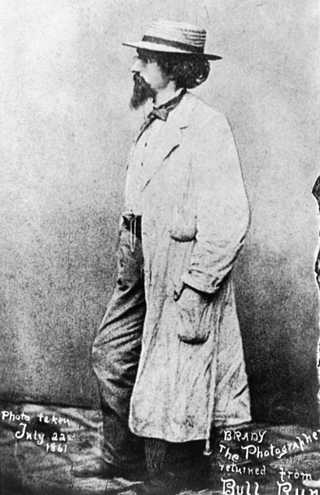Mathew Brady
|
Brady after Bull Run, July 22, 1861, from LC
|
Links:
- A Nationalizing Power and Communications Revolution
- Mathew B. Brady Biographical Note in Selected Civil War Photographs Collection from LC
- Mathew Brady's Portraits from NPG includes a virtual tour ofMathew Brady NY Studio
- Benfey, Christopher. Theater of War. The real story behind Mathew Brady's Civil War photographs. A review of the exhibit "Mathew Brady's Portraits: Images as History, Photography as Art" at the National Portrait Gallery, Washington, D.C. Slate, Oct. 30, 1997.
Sources:
- Horan, James D. Mathew Brady, Historian With a Camera. New York: Crown Publishers, 1955. 244 p.
- Kunhardt, Dorothy Meserve and Philip B. Kunhardt, Jr. Mathew Brady and his World. Alexandria VA: Time-Life Books, 1977. 303 p.
- Panzer, Mary. Mathew Brady and the Image of History. Washington, DC: Smithsonian Institution Press for the National Portrait Gallery, 1997. 232 p. Catalog for an exhibition at the National Portrait Gallery, Sept. 26, 1997-Jan. 4, 1998
- Sullivan, George. In the Wake of Battle: the Civil War Images of Mathew Brady. New York: Prestel, 2004. 445 p.
revised 8/15/05 by Steven Schoenherr at the University of San Diego
